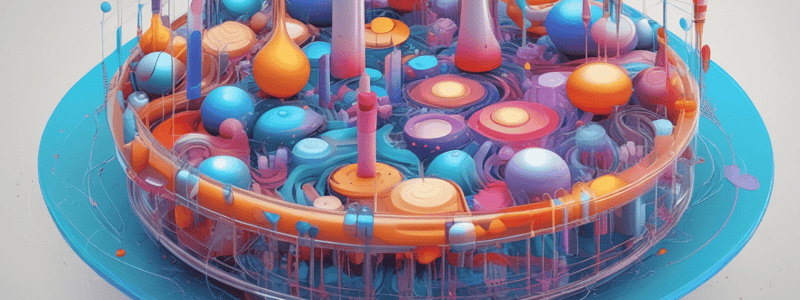Podcast
Questions and Answers
What is the formula for the time of residence (tr) of a particle in a channel for diffusive mixing?
What is the formula for the time of residence (tr) of a particle in a channel for diffusive mixing?
- tr = lchannel / vmean (correct)
- tr = lchannel * vmean
- tr = lchannel^2 / vmean
- tr = vmean / lchannel
In the context of passive diffusive micromixers, what does the diffusion time (tD) represent?
In the context of passive diffusive micromixers, what does the diffusion time (tD) represent?
- Time taken for particles to accelerate in the channel
- Time taken for particles to mix perfectly
- Time taken for particles to reach the end of the channel
- Time taken for particles to diffuse across the channel width (correct)
What is the minimum channel length required for complete diffusive mixing in a microfluidic system?
What is the minimum channel length required for complete diffusive mixing in a microfluidic system?
- lchannel = D / vmean^2
- lchannel = tD / vmean
- lchannel = vmean / tD
- lchannel = vmean^2 / D (correct)
In a Y-mixer design, what is the role of laminar flow in achieving mixing?
In a Y-mixer design, what is the role of laminar flow in achieving mixing?
Which parameter determines the minimum channel length for complete mixing in a passive diffusive micromixer?
Which parameter determines the minimum channel length for complete mixing in a passive diffusive micromixer?
How can the channel length be shortened in microfluidic systems?
How can the channel length be shortened in microfluidic systems?
What happens when the diffusivity D is too small in the context of microfluidic systems?
What happens when the diffusivity D is too small in the context of microfluidic systems?
Which technique is used for passive mixing by interdigitated lamella in microfluidic systems?
Which technique is used for passive mixing by interdigitated lamella in microfluidic systems?
How is the minimum channel length reduced by layering techniques in microfluidic systems?
How is the minimum channel length reduced by layering techniques in microfluidic systems?
In the context of microfluidic systems, what effect does reducing diffusion length have on the channel design?
In the context of microfluidic systems, what effect does reducing diffusion length have on the channel design?
What is the main purpose of passive diffusive micromixers in microfluidic systems?
What is the main purpose of passive diffusive micromixers in microfluidic systems?
What is the primary advantage of using diffusive mixing in microfluidic systems?
What is the primary advantage of using diffusive mixing in microfluidic systems?
In a Y-mixer configuration, what determines the extent of diffusive mixing between the two inlet fluid streams?
In a Y-mixer configuration, what determines the extent of diffusive mixing between the two inlet fluid streams?
What is the relationship between the diffusion length ($l_D$) and the time required for complete diffusive mixing ($t_D$) in a microfluidic channel?
What is the relationship between the diffusion length ($l_D$) and the time required for complete diffusive mixing ($t_D$) in a microfluidic channel?
In a microfluidic channel with laminar flow, what is the diffusion length ($l_D$) typically defined as?
In a microfluidic channel with laminar flow, what is the diffusion length ($l_D$) typically defined as?
Which of the following statements regarding passive diffusive micromixers is correct?
Which of the following statements regarding passive diffusive micromixers is correct?
What is the primary limitation of passive diffusive micromixers compared to active micromixers?
What is the primary limitation of passive diffusive micromixers compared to active micromixers?
Flashcards
Time of Residence (tr)
Time of Residence (tr)
The time a particle spends in the channel during mixing.
Diffusion Time (tD)
Diffusion Time (tD)
Time taken for particles to diffuse across the channel width.
Minimum Channel Length for Mixing
Minimum Channel Length for Mixing
The minimum length required for complete diffusive mixing is lchannel = vmean^2 / D.
Laminar Flow in Y-mixer
Laminar Flow in Y-mixer
Signup and view all the flashcards
Minimum Channel Length Parameter
Minimum Channel Length Parameter
Signup and view all the flashcards
Shortening Channel Length
Shortening Channel Length
Signup and view all the flashcards
Effect of Small Diffusivity (D)
Effect of Small Diffusivity (D)
Signup and view all the flashcards
Layering Technique
Layering Technique
Signup and view all the flashcards
Reduction of Minimum Channel Length
Reduction of Minimum Channel Length
Signup and view all the flashcards
Reducing Diffusion Length Impact
Reducing Diffusion Length Impact
Signup and view all the flashcards
Purpose of Passive Diffusive Micromixers
Purpose of Passive Diffusive Micromixers
Signup and view all the flashcards
Advantage of Diffusive Mixing
Advantage of Diffusive Mixing
Signup and view all the flashcards
Extent of Diffusive Mixing in Y-mixer
Extent of Diffusive Mixing in Y-mixer
Signup and view all the flashcards
Diffusion Length ($l_D$)
Diffusion Length ($l_D$)
Signup and view all the flashcards
Passive Diffusive Micromixers' Operation
Passive Diffusive Micromixers' Operation
Signup and view all the flashcards
Limitation of Passive Micromixers
Limitation of Passive Micromixers
Signup and view all the flashcards



